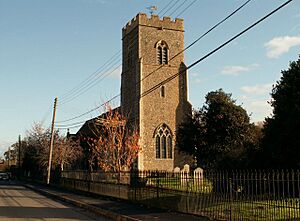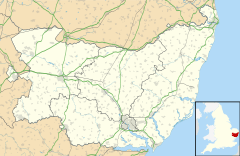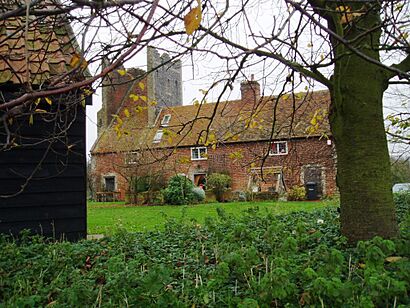Tattingstone facts for kids
Quick facts for kids Tattingstone |
|
|---|---|
 St Mary's parish church |
|
| Population | 540 (2011 Census) |
| OS grid reference | TM1337 |
| Civil parish |
|
| District |
|
| Shire county | |
| Region | |
| Country | England |
| Sovereign state | United Kingdom |
| Post town | Ipswich |
| Postcode district | IP9 |
| Dialling code | 01473 |
| Police | Suffolk |
| Fire | Suffolk |
| Ambulance | East of England |
| EU Parliament | East of England |
| Website | Tattingstone Village |
Tattingstone is a lovely village in Suffolk, England. It's located on the Shotley peninsula, about 5 miles south of Ipswich. In 2011, about 540 people lived here.
Contents
Discovering Tattingstone's Past
The village of Tattingstone has a long and interesting history. Its name, Tatituna or Tatistuna, was first written down in the Domesday Book way back in 1086.
Tattingstone is home to Tattingstone Place and a very unusual building called the Tattingstone Wonder. This "wonder" is actually a row of cottages that look like a church! It has a special front made of flint and a fake tower.
Village Settlements and Changes
The parish of Tattingstone has three main areas. The biggest part includes the church, Tattingstone Park, and a building that used to be a workhouse. This workhouse later became St Mary's Hospital. In 1991, it was turned into homes.
Another area is Tattingstone Heath, found along the A137 road. There's also a small group of houses near the White Horse pub. This area is connected to the rest of the village by Lemons Hill bridge, which goes over the western end of Alton Reservoir.
Tattingstone Estate and Church
The Tattingstone Estate was given to Mr. Western in 1808 by his father's cousin, Thomas White. Tattingstone Church has a special burial area for Thomas Western, who passed away in 1814, and his wife Giulietta Roman, who died in 1850. Thomas White, who died in 1808, is also buried there.
Creating Alton Water Reservoir
In the 1970s, a big change happened in Tattingstone. The valley was flooded to create a huge reservoir, covering about 400 acres. This split the village into two parts.
Alton Mill's New Home
Alton Mill, a building that stood in the way of the new reservoir, was carefully taken apart. It was then moved and rebuilt at the Museum of East Anglian Life in Stowmarket. This way, a piece of history was saved!
Lost Homes and a New Pavilion
Sadly, Tattingstone Alton Hall was not saved and disappeared under the water. More than twenty houses and two farms were also flooded to make space for the reservoir.
The pavilion on the village playing field was built using parts from an old boat house. This boat house used to be on the lakes that were in the valley before the flooding. Five local men from the village built the pavilion.
Alton Water Today
The reservoir is now managed by Anglian Water and is known as Alton Water. It's a wonderful place for wildlife to live. People also enjoy visiting Alton Water for cycling, walking, fishing, and other watersports.
Special Buildings in Tattingstone
Tattingstone has twenty buildings that are officially "listed." This means they are important and protected because of their history or special design. Two of these are extra special and are called "grade II* listed." These are the church of St Mary and the famous Tattingstone Wonder.
The Tattingstone Wonder Explained
The Tattingstone Wonder is a very unusual building, built around 1790 for the local Squire, Edward White. He lived in the Hall nearby. It started as two cottages, but then a third was added. A fake church tower and front were also built onto it. Squire White wanted to give his neighbours "something to wonder at," and he certainly did!
Village Pubs
The village has two pubs where people can gather: the Wheatsheaf and the White Horse. There used to be a third pub called the Orange Box, which was also a village shop and post office. It closed in 2000 and the building was taken down that same year.
Well-Known People from Tattingstone
Many interesting people have lived in Tattingstone over the years:
- Ann Candler (1740–1814) was a poet known as The Suffolk Cottager.
- Edward Pearson (1756–1811) was a clever academic and theologian. He was the Master of Sidney Sussex College, Cambridge and a Vice-Chancellor at the University of Cambridge.
- John Preston Neale (1780–1847) was an artist who drew buildings and landscapes.
- Charles Boileau Elliott (1803–1875) was a travel writer and a clergyman who served as the rector of the parish.
- Basil Snell (1907-1986) was also a clergyman who held important roles as Archdeacon of Bedford and Archdeacon of St Albans. He was also a rector of the parish.
- John Lyall (1940-2006) was a famous footballer and manager for teams like West Ham United and Ipswich Town F.C..
- Rear Admiral Thomas Western (1761-1814) was a Royal Navy officer. His special monument in the church was created by the famous artist John Flaxman.



